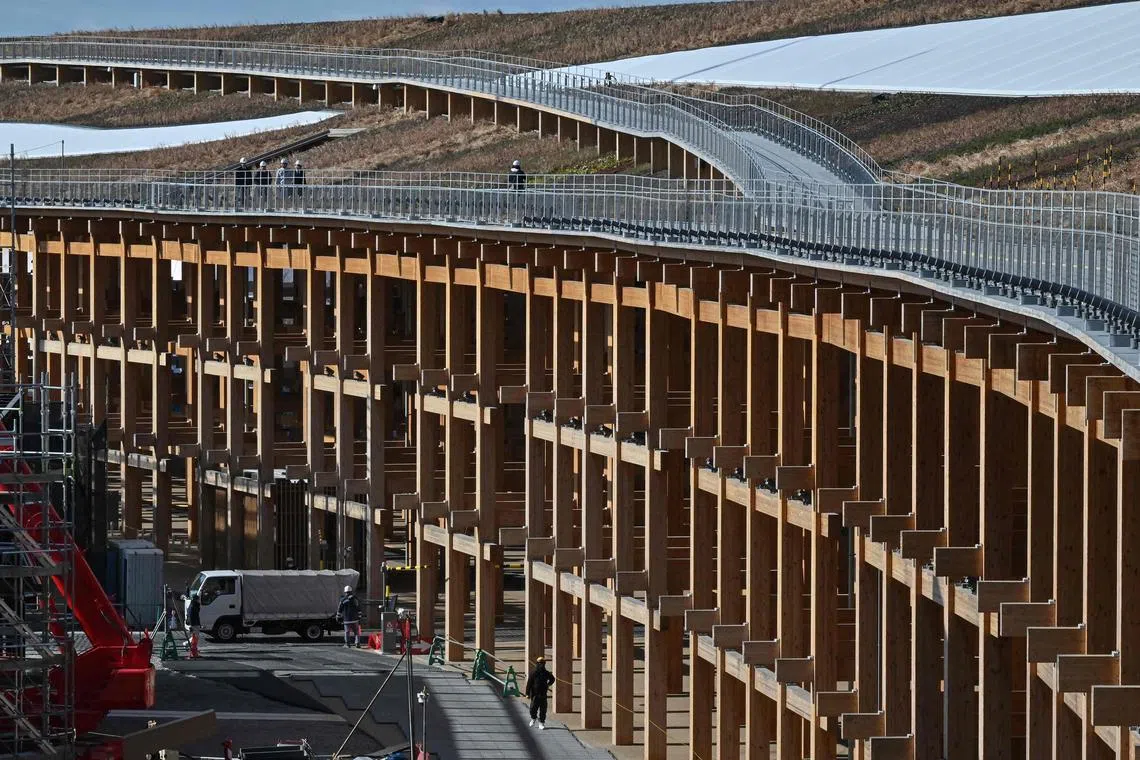What’s the future of life? Osaka Expo asks big questions but public interest tepid before launch
Sign up now: Get ST's newsletters delivered to your inbox

Workers are pictured at the Singapore Pavilion for the 2025 Osaka Expo on Jan 17.
PHOTO: AFP
Follow topic:
OSAKA – A pulsating heart made from stem cells is among the top draws at the upcoming Osaka World Expo, which runs for six months from April 13.
The beating organ, while small, is unlike mechanical artificial hearts or pacemakers, which are made from inorganic materials, in being derived entirely from human cells. These induced pluripotent stem (iPS) cells are generated by extracting adult patient cells – such as skin – and “reprogramming” them for desired functions by transforming them into an embryo-like state.
Osaka-born scientist Shinya Yamanaka was awarded the Nobel Prize in 2012 for his discovery of such cells, which researchers hope can lead to a breakthrough in medicine by repairing damaged tissues or organs. Showcasing the “iPS heart” at the Expo will demonstrate the potential to treat patients with weakened heart functions, Osaka University cardiologist Yoshiki Sawa said.
The exhibit, housed within a pavilion by Japanese human resources agency Pasona Group, is what Osaka Governor Hirofumi Yoshimura told foreign media on Feb 17 he was most excited to see at the Expo, which will be held on the reclaimed Yumeshima (Dream Island) on Osaka Bay.
With the theme Designing Future Society For Our Lives
The event essentially brings the world, through the exhibits, to Japan, whose 21.6 million passport holders as at December 2024 accounted for a mere 18 per cent of its citizen population.
Organisers are targeting 28.2 million people at the Expo, including 24.7 million Japanese nationals.
The big question, however, is: Will they come?
The 7.87 million advance tickets sold as at Feb 19 remain far below the targeted 14 million advance tickets, with just around 50 days to go before the event is launched. What is more, about 80 per cent of these tickets had been bought by businesses for resale to their employees or distribution to clients.
Sumitomo Electric chief executive Masayoshi Matsumoto, who heads the Kansai Economic Federation, said on Feb 13 that while he believed in the event’s success, “above everything else, we must urgently sell tickets to avoid incurring a loss”.
A Feb 15-16 survey by the Mainichi daily found that two in three Japanese have no intention of visiting the Expo.

Part of the Grand Ring – touted as among the largest wooden structures in the world – constructed for the 2025 Osaka Expo, which will open on April 13 on the reclaimed Yumeshima island.
PHOTO: AFP
These findings are in line with another poll in December 2024, commissioned by the Osaka prefectural and city governments, that showed just 34.9 per cent of respondents wished to attend the event. Interest is higher in the Kansai region, where Osaka is located, but declined with distance.
Past Expos have shown slow starts, only for attendee numbers to spike in the final weeks of the event.
Mr Yoshimura is optimistic that momentum and fanfare will grow alongside media coverage and social media word-of-mouth after the Expo opens.
In response to a question from The Straits Times, he admitted to the challenges: “It is true that ticket sales are sluggish, and building national momentum is a major issue.”
But he added: “We believe interest will grow as the details of the Expo become clearer, such as the types of exhibits and experiences on offer.”
The public’s indifference follows a spate of bad press
There was also a chorus of complaints about the online ticketing system, which requires ticket buyers to first register for an online account. Mr Yoshimura acknowledged these grievances and vowed to look into simplifying processes further.
Already, organisers have backed down from an initial plan to make tickets – both advance and same-day – available only electronically, ostensibly for crowd management purposes.
Convenience stores and travel agencies began selling paper tickets from October 2024, while discussions are afoot to set up same-day ticket counters at the door throughout the Expo.
Japan is hosting the five-yearly international event for the third time, with the Expo returning to Osaka after 55 years. Aichi held the event in 2005.
Prime Minister Shigeru Ishiba, who visited the 1970 Osaka Expo three times as a teenager, has made the success of 2025’s event a national priority. He said: “The thinking must not be that ‘this is just an Osaka event’. I will do everything in my power to ensure the Expo can catalyse growth opportunities for Japan.”
Preparations are now in the home stretch. The Yumeshima subway station that connects the Expo venue to the city centre within 30 minutes opened on Jan 19.
The renovated Kansai International Airport (KIX) will hold its grand opening on March 27, following the completion of enhanced passenger facilities.
Representative director Benoit Rulleau of Kansai Airports, which manages Kansai, Osaka-Itami and Kobe airports, said the upgrading was necessary to address a design flaw in Terminal One, the airport’s main terminal.
KIX opened in 1994, with the terminal designed to accommodate 12 million international arrivals and 13 million domestic flight passengers. By 2018, however, it was welcoming 20.6 million international arrivals and just four million domestic flight passengers, with Osaka’s location near enough to large population centres like Tokyo and Fukuoka to be highly accessible to commuters by the shinkansen, Japan’s high-speed rail.
“There was way too much capacity for domestic passengers, not enough for international, and a lot of space that could be used in a better way,” Mr Rulleau said.

A life-sized Gundam statue kneels on one knee outside video game publisher Bandai Namco’s pavilion at the Osaka World Expo, which opens on April 13 on the reclaimed island of Yumeshima.
PHOTO: AFP
With the redesign, international passengers will have more seamless arrival and departure procedures – security checkpoints have a peak capacity of 6,000 passengers an hour, up from 4,500 – and more duty-free retail options.
Meanwhile, Expo participants, including individual countries, as well as Japanese companies, municipalities and eight commissioned producers who are individuals, have been unveiling their line-up to attract visitors.
Singapore, whose pavilion is an eye-catching red sphere
“As we are caught up in our hectic daily lives, it is very easy to forget about dreams and what the future holds,” said Ms Carrie Kwik, the Singapore Tourism Board’s executive director for the World Expo and special projects.
“The Singapore Pavilion will appeal to the world about the importance of not just dreaming your dreams, but also bringing them to life,” she said.
Among the eight producers is Japan’s top roboticist Hiroshi Ishiguro, whose pavilion is based on the theme “amplification of lives”. He said on Feb 19 that he wants visitors to experience a world where androids and robots are as integral a part of society as humans.
Ultimately, said Osaka World Expo secretary-general Hiroyuki Ishige, he hopes the event would leave its mark
“Unlike symposiums or conferences for technical experts and the elite, the Expo is an event for the public to come together, meet people from around the world, and collectively imagine the future and think about a better tomorrow,” he said.
Tickets are available online at /
Walter Sim is Japan correspondent at The Straits Times. Based in Tokyo, he writes about political, economic and socio-cultural issues.


